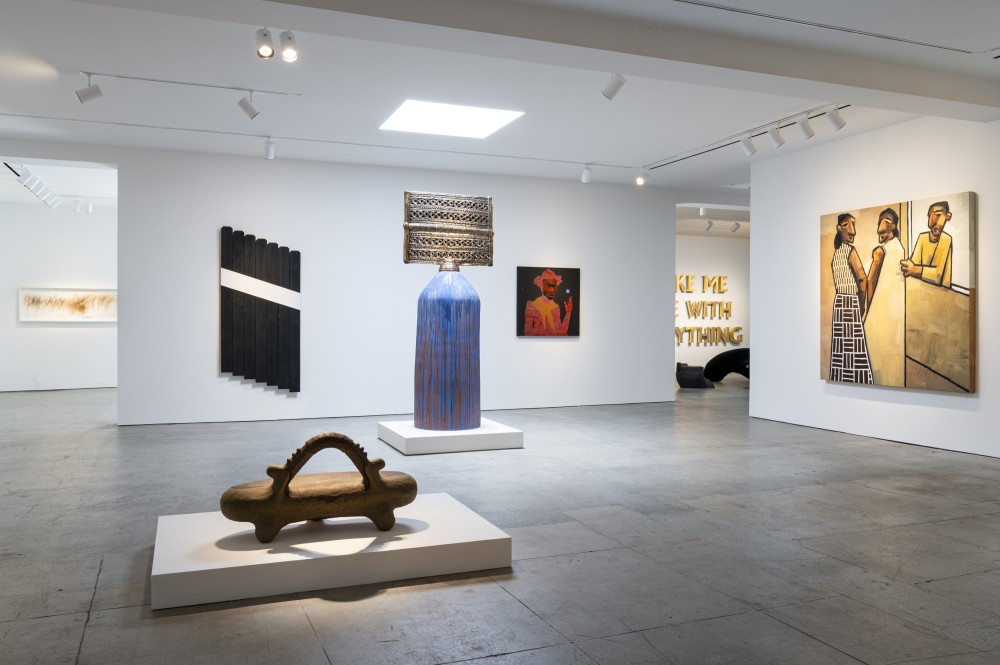
United State
United State, an exhibition of over 25 African and American artists, opens at Southern Guild Los Angeles on Saturday, 13 September (on view until 4th November, 2025). Conceived as a living forum rather than a static presentation, the exhibition is an invitation for inclusion, empathy, kinship and exchange as a counterforce to the accelerating socio-political polarisation of our time. Bringing sculpture, painting, textile work, photography and collectible design into dynamic relation, United State asserts the radical need for plurality in a moment when perceptions of freedom and diversity are narrowing. The exhibition functions as a manifesto: a call to action to work together towards a shared humanity.
The exhibition deepens the trans-Atlantic reciprocities Southern Guild has sought to generate since opening its Los Angeles gallery in early 2024. Over the past two years, the gallery has engaged with a host of US-based artists, mostly in LA, who have formed vital connection points to the city. Work by six such artists – Tonia Calderon, Chloe Chiasson, Tofer Chin, Simphiwe Ndzube, Ferrari Sheppard and Chiffon Thomas – is presented alongside seminal voices from the gallery’s programme: Kamyar Bineshtarigh, Belinda Blignaut, Patrick Bongoy, Cheick Diallo, Andile Dyalvane, Jesse Ede, Jozua Gerrard, Katherine Glenday, Porky Hefer, Alexandra Karakashian, Bonolo Kavula, Terence Maluleke, Manyaku Mashilo, Chuma Maweni, Rich Mnisi, Nandipha Mntambo, Zanele Muholi, Brett Murray, Mmangaliso Nzuza, Oluseye, Zizipho Poswa, Usha Seejarim and Stanislaw Trzebinski.
In United State, Southern Guild crystallises its evolution, welcoming a breadth of practices that affirm the gallery’s position as a guardian of traditional knowledge systems and a platform for speculative, visionary futures. Amidst the vast heterogeneity of medium and perspective, there is a sense of possibility, of forging vocabularies that are disruptive and playful, urgent and necessary. The exhibition foregrounds artists whose trajectories resonate with the gallery’s values of cultural storytelling, craft as resistance, and authentic social resonance.
The exhibition platforms human-centred modes of making, non-traditional approaches to materiality, and the blurring of boundaries between subject, form and function. The featured artists look to both collective histories and personal mythologies, addressing themes of race, gender identity, class, social belonging and community.
Portraiture is a tool for visibility and liberation in Muholi’s invocations of Black Queer identity, and a declarative claiming of space in Nzuza’s painterly approach to volumetric figuration. Poswa’s totemic ceramic sculptures monumentalise symbols of African womanhood, while Kavula’s latticed abstractions, meticulously constructed from shweshwe fabric, embody the tender persistence of generational memory and the labour of cultural preservation. Ndzube’s figures lean into the mythic, populating a densely textured, surreal setting he calls the “Mine-moon”, an oblique fictionalisation of post-Apartheid South Africa. Sheppard’s paintings, incorporating loose charcoal linework and goldleaf, combine the quotidian and the archetypal, framing Black identity beyond the narratives of trauma and marginality, positioning it instead within registers of beauty, power and transcendence.
Like Ndzube, Chin’s practice blurs the lines between two- and three-dimensional media. Inspired by LA’s urban cultures, he creates minimal compositions he calls “abstracted landscapes” that play with perception and engage with their physical setting – including a site-specific mural created for United State on the gallery’s exterior wall on N Western Avenue. Thomas has developed an expressive visual language and application of materiality – including hand embroidery, collaged found material and paint – to interpret personal feelings of nostalgia, longing to belong and affirmations of self-identity.
Place as a shaper of identity features heavily in the practice of Dyalvane, whose large- scale ceramic work is titled after his home village in the rural Eastern Cape province of South Africa. Forming part of his ground-breaking iThongo series, the sculpture honours the spiritual seat of his Xhosa cosmology – close to the earth, in communion with his ancestors. Similarly concerned with the memorialisation of place, Iranian-born Bineshtarigh’s mixed-media works are enquiries into the politics and complexities of mark-making as traces of presence, labour and erasure.
Several artists – including Hefer, Calderon, Blignaut and Trzebinski – work in intimate dialogue with the natural world, appealing for the recovery of environmental and cultural practices destabilised by industrialisation and climate change. Blignaut’s ceramic forms, hand-built from foraged ‘wild clay’, contain organic remnants of animal bone and plant matter, becoming vessels of site and story. Similarly, Calderon’s abstract paintings made from flower pigments, natural materials and chemical compounds are layered reflections on the beauty and fragility of existence, informed by her Mexican, Dutch, Indonesian and Chinese heritage. Hefer’s inhabitable ‘animal architecture’ is rooted in the subversive power of play as a means to ignite more creative, connected and humane modes of relating to our environment and each other. Kenyan-born Trzebinski’s surreal bronze sculptures reckon with climate devastation, inspired by nature’s resilience and adaptive capacity.
Who are ‘we’? What do we stand for in times of rupture and unrest? Where do we place our energy amidst change, towards fragmentation or connectivity? How do we cultivate reimagined understandings of place, meaning and futurity? United State does not simply respond to a fractured global present - it insists on new passages for collective becoming.